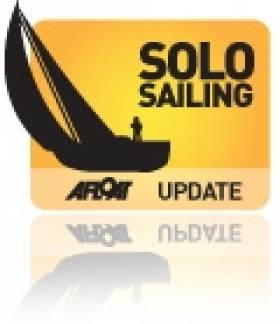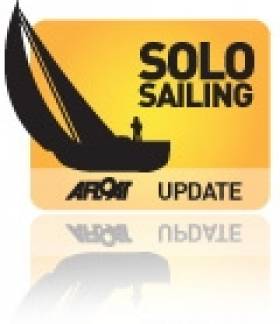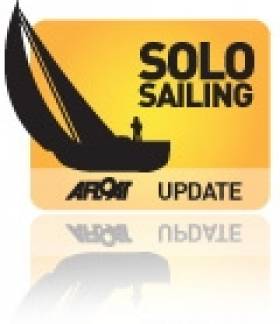Displaying items by tag: Mini Transat
Dolan Moves Up One Place in Mini Transat
With a strong following wind off the coast of Portugal, Ireland's sole entry in the Mini–Transat race made a gain overnight in his mid-fleet position. County Meath's Thomas Dolan lies 18th overall from 44 starters in the solo race and 100 miles off the overall leader.
The Minis 'bowled' along the Portuguese coast, with the same worry in each person's mind: the best way to attack, whilst also keeping the boat under control. In this constant game, it's experience that makes the difference.
It's not by chance that, with a few exceptions, the old hands of the Mini circuit are in the leading places in this first stage of the Mini Transat Iles de Guadeloupe. At the moment, the ig guys are justifying their reputations and they are all in contention to vie for the best positions. Davy Beaudart (Flexirub), who has been the race favourite, is keeping hold of his place with gusto, and fighting off the attacks by the furious trio of Axel Trehin (Aleph Racing), Frederic Denis (Nautipark) and Ludovic Mechin (Microvitae). Amongst these three, some sort of gentleman's agreement has come about: instead of each of them fighting all the time, they are taking it in turns to rest and attack. This isn't just an altruistic thing, as it also lets them use their boats to full potential, whilst decreasing the risk of breakages.
The possibility of breakages is of course always with them, and there have already been two demastings (Gilles Avril et Andrea Pendibene) and several other competitors, such as Carlos Lizancos have thrown in the towel, or made a stop for repairs.
Positions on 23rd September at 3pm (TU+ 2)
Prototypes ( Eurovia Cegelec class)
1. Davy Beaudart, Flexirub, 597 nm to the finish
2. Frederic Denis, Nautipark, 31.9 nm to leader
3. Axel Trehin, Aleph Racing, 33 .3 nm
4. Ludovic Mechin, Microvitae, 37.5 nm
5. Clement Bouyssou, Le Bon Agent Bougeons l'immobilier, 38.3 nm
Series (Ocean Bio-Actif class)
1. Ian Lipinski, Entreprise(s) Innovante(s), 661 to the finish
2. Benoit Hantzperg, YCA Dhumeaux - Secours Populaire, 2.9 nm
3. Tanguy Le Turquais, Terreal, 14.8 nnm
4. Julien Pulve, Novintiss, 23.0 nm
5. Charly Fernbach, Le Fauffiffon Henaff, 50.1 nm
Tom Dolan Makes Good start for Ireland in Mini Transat
Irish solo sailor Tom Dolan's dream of competing in this year's Mini–Transat came true yesterday when the County Meath man departed Douarnenez in France and embarked on his 4000–mile race.
It’s hard to imagine better conditions for the start of the Mini Transat îles de Guadeloupe. The President of the racecourse fired the starter’s pistol, and the competitors launched themselves into the westerly to north-westerly 8-10 knot wind. By the end of the first part of the race in the bay, the favourites were already pointing their bows towards the open ocean.
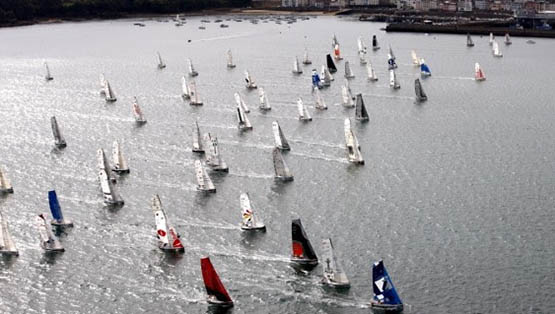
Yesterday's start in Douarnenez Bay
You can follow Tom's progress via the race tracker
There was enough wind to move forwards, but not too much. We couldn’t have hoped for more at the start of a transatlantic race, both for the competitors, and for the organisers. Douarnenez Bay had dressed up in its finery: blue skies, light clouds at the top of Menez Hom, dark seas…
The Mini Transat îles de Guadeloupe racers hardly had time to admire the landscape. Instead they had to watch their rivals, avoid collisions and consider their tactics for the best approach to the race in Douarnenez Bay.
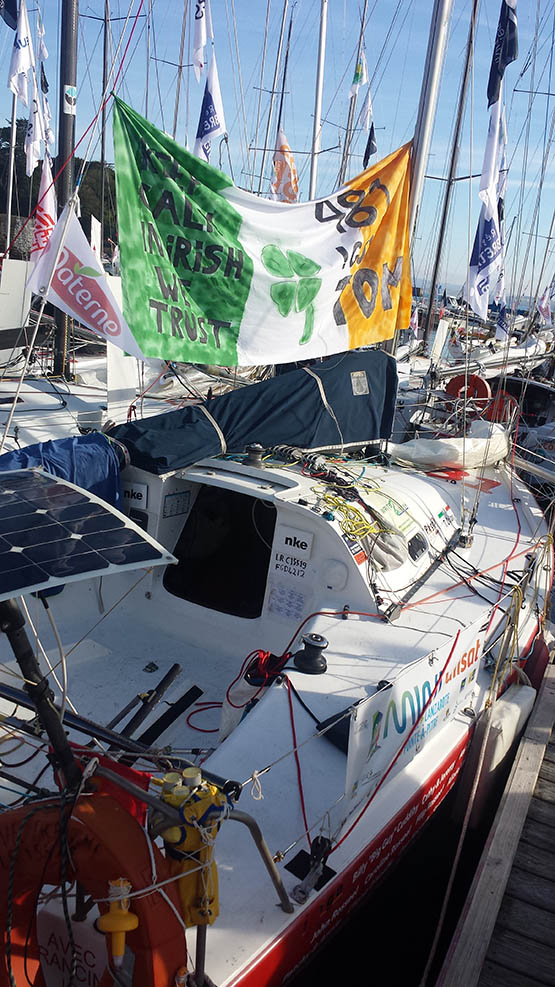
The County Meath yacht is prepared for the off in Douarnenez – Photo: Paul Keane
After a beautiful start on the starboard side, Hervé Aubry (Ixina – Voilerie HSD) was in the lead, followed closely by the youngest competitor, Quentin Vlamynck (Arkema) and Clément Bouyssou (Le Bon Agent ! Bougeons l’Immobilier). However, it was Davy Beaudart (Flexirub), followed by Frédéric Denis (Nautipark) who were leading the fleet at the first buoy. Next, was Julien Pulvé (Novintiss) who overtook Benoît Hantzperg (YCA – Dhumeaux – Secours Populaire).
Tacking re-shuffles the playing cards
At buoy number 2, Fred Denis had taken matters into his own hands, thanks to an ingenious double tack in the direction of the coast. Many of the following competitors took advantage of these tactics to improve their times and re-join the leaders of the fleet, including an inspired Fidel Turienzo (Satanas).Benoît Hantzperg also profited from this windfall to pinch first place from Julien Pulvé, whilst Tanguy Le Turquais manouevred his Terréal into third position.
This was followed by a stretch of quite closed spinnaker sailing in a straining wind that forced a real break amongst the favourites in training at the centre of the fleet, particularly caused by the comfortable conditions. For others, the problem was that they had hardly experienced this type of sailing on a razor’s edge. A first hierarchy had established itself by the time they reached the buoy at Tristan island, which marks the end of the coastal run. Ahead of them unfolded a long stretch towards the west until they crossed the Seine current. The objective was to get around a light patch sitting directly in their path, and look for a faster route by using the winds from the northwest.
Lucky for some…unlucky for others
For the majority of the fleet, the positioning in the coastal race was an epiphany, to know who to look out for in the following week. Tomorrow, when the first night is over, each one of them will have forgotten the little miserable moments they will have during these 5,000 miles of prelude to the main race. Even Axel Tréhin (Aleph Racing), who tried to make too tight a turn around the first buoy, and was entangled for a long time in its moorings, will have forgotten about how many positions he dropped because of his greedy attempt.
It’s another story for Nacho Postigo. He was violently slammed against the rocks of Tristran Island when he was being towed by an organiser’s boat, and saw his hopes for the Transat dashed as well. With his keel sail damaged and the bulb mashed up, the Spanish sailor could not go straight back to the race. However, he will be able to re-join the ranks in two stages, as the crash was not his responsibility. The international jury will need to decide under what criteria he can re-join the race. The members already know that there will be the work cut out waiting for him to do in Lanzarote.
Positions after the coastal race:
Prototypes (Eurovia Cegelec class):
1 Fred Denis – 800 – Nautipark
2 Davy Beaudart – 865 – Flexirub
3 Clément Bouyssou – 802 – Le Bon Agent ! Bougeons l’Immobilier
4 Luke Berry – 753 – Association Rêves
5 Jean-Baptiste Daramy – 814 – Chocolats Paries – Coriolis Composites
Séries (Ocean Bio-Actif Ranking)
1 Benoît Hantzperg – 871 – YCA – Dhumeaux – Secours Populaire
2 Tanguy Le Turquais – 835 – Terréal
3 Charly Fernbach – 869 – Le Fauffiffon Hénaff
4 Antonio Fontes – 745 – Vela Solidaria
5 Ian Lipinski – 866 –Entreprises Innovantes
#minitransat – On 19 September 2015, Ireland will be among 84 Mini–Transat 2015 competitors heading out to do battle with the Atlantic for the 20th edition of the Mini Transat. As was the case in 2013, the race will set sail from Douarnenez in north-west Brittany. County Meath sailor Tom Dolan launched a Mini Transat solo sailing campaign in December as Afloat previously reported.
Dolan's first qualifying race is the 150–miles double–handed Lorient Bretagne Sud Mini race on April 11.
For this second edition starting out from Douarnenez - the third if we go back to 1991 when the town first hosted the Mini Transat - the Douarnenez Courses team is building on past experience whilst ensuring continuity with a return to Douarnenez' first harbour, the basin of Port Rhu, a genuine showcase for the Mini fleet that proved so successful in 2013.
With some 78 racers already pre-registered, the Mini Transat is once again guaranteed to have a full line-up. Among the entries we find some of last edition's front runners in the proto ranking including Michele Zambelli, Ludovic Mechin and Romain Mouchel, who are back once more to try their luck. They'll be joined by some of the movers and shakers of the Mini Class, who have traded in their series boats for a prototype, such as Clement Bouyssou and Davy Beaudart with his Maximum, the sistership to the famous Magnum, which won the Mini Transat 2011 and secured second place in the Mini Transat 2013.
In the series fleet, all eyes will be on the battle between the Nacira designs, which dominated the competition in 2013 in the hands of Damien Cloarec, Jonas Gerckens and Patrick Girod. Also worth following are the Argos, led by Tanguy Le Turquais, and the two latest newcomers (provided they are granted the status of a series boat), the Pogo 3 and the Ofcet, skippered by Ian Lipinski and Julien Pulve respectively.
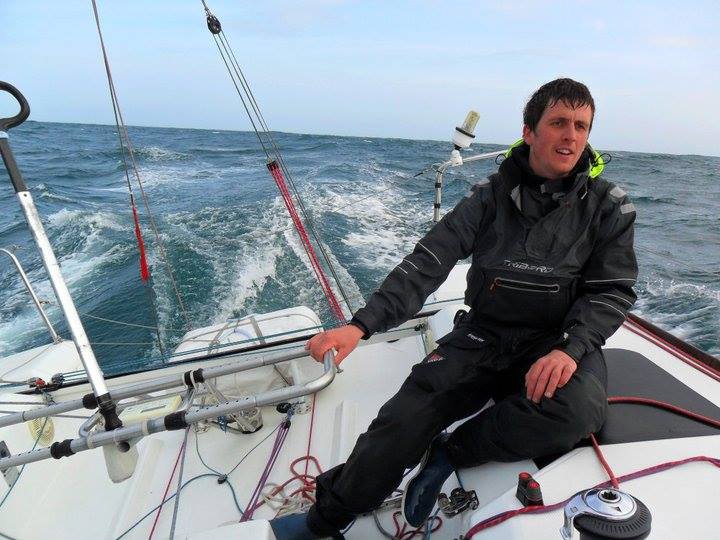
County Meath sailor Tom Dolan
More on www.minitransat.fr
Meath Sailor Launches Mini Transat Campaign for 2015
#ClasseMini – A County Meath sailor has launched a Mini Transat solo sailing campaign for 2015. Tom Dolan has announced his intention to participate in the 2015 Classe Mini Offshore Racing Championship, culminating in the renowned Mini–Transat Race starting on September 19.
The first qualifying race is the 150–miles double–handed Lorient Bretagne Sud Mini race on April 11.
Dolan, who says 'he was never part of a yacht club, never went on sailing holidays and didn't get lessons as a child' only began sailing when his father spotted an old wooden dinghy in the "buy and sell" and the two of them set about fixing it up. He first set sail on the local lake in County Meath age ten.
Starting 'at the bottom' he worked as a volunteer with the Glenans sailing school, which gave him access to bigger boats as well as the open ocean. He has been working professionally in sailing since 2007, in Ireland, France and the Caribbean, accumulating over 10,000 miles at sea.
His CV includes French, Irish and British qualifications and he first crossed the Atlantic at the age of 21. Now he has his sights keenly fixed on offshore racing.
The boats are the smallest ocean racing class in the world, measuring in at 6.5 metres, while carrying almost 100 square metres of sail. The spirit of the class is to make solo offshore racing accessible to every-day people. In modern times it has become a stepping stone into the world of professional offshore racing. I have managed to get my hands on a Pogo 2, one of the most popular brands of Mini 650s, which I hope will give me an even playing field in the class.
The 4000 mile Mini Transat race, which has been running since 1977, is considered by many as one of the most extreme in sailing, due to the combination of the size of the boats involved and the distance covered by them.
Writing in the latest edition of the Beacon, the newsletter of the Baltimore Maritime Centre, Dolan outlines his plans for next season:
'The race starts from Brittany on the western coast of France and is divided into two legs. The first leg involves crossing the infamous Bay of Biscay, known for its mountainous waves which are thrown up as the continental shelf meets the oceanic abyss and depths shoot from 4000 metres to 100 over a distance of a couple of miles.
Once the NW point of Spain is rounded, it's a drag race down the Iberian coast across the mouth of Gibraltar, dodging cargo ships, to the pit stop in Lanzarote, in the Canary Islands.
Following a short stay to await the end of the hurricane season, the race sets off into the vast Atlantic ocean for three weeks (all going well!) at sea, trying to negotiate the best route across on the back of the one way rollercoaster that is the westerly trade winds with no chance of turning back.

Tom Dolan sailing on his Mini 481. Photo: Tom Dolan Sailing
The finish is the tropical Island of Guadeloupe, in the French Caribbean.
In order to qualify, there are certain challenges that need to be met:
• Complete 1000 race miles in the season
• Complete a 1000 mile solo non-stop qualifying passage from La Rochelle to the Coningbeg buoy and back.
• Complete at least one solo race
Should I manage to qualify, I will be Ireland's third ever entry, and Meath's first!
An intense winter training programme will begin in January at the "Centre d'Entrainement Mini de Concarneau". There I will train alongside 10 of my counterparts in preparation for the season which kicks off at the beginning of April with the "Lorient BSM" race. Before the Transat, there are 6 races in the season, all of which are run along the Breton coast. I aim to do them all but a lot will depend on the budget I will be able to put into the project. So that means throwing on my nice shirt and tie and knocking on board room doors either side of the Celtic sea in the hope of gaining support. The sailing will be the easy part!'
More on facebook
Mini Transat Fleet Finally Prepare to Start Racing
It's on ... The weather will finally allow the fleet of 84 Minis to leave the shores of Brittany on Mini Transat 2013. Although the crossing of the Bay of Biscay should be completed safely, the passage around Cape Finisterre could be tricky for the final competitors. However, it by far the best conditions for the past two weeks.
On the one hand, they all want to escape from Douarnenez despite the quality of the welcome of the Cornouaillais port and its inhabitants . But at the same time, the road ahead is not going to be a bed of roses. The main obstacle on the way to Lanzarote, is in the vicinity of Cape Finisterre, as their arrival there may coincide with a strengthening in the wind of up to 30 knots. Conditions that will be far from comfortable, but that should not be an insurmountable obstacle for the fleet of Minis. However, Denis Hughes, the Race Director, reminded everyone during the weather briefing on Monday night, that each competitor has the right to stop for 48 hours in a port of his choice, as stated in the sailing instructions.
To cross the Bay of Biscay, the fleet is expected to start in a regime of northwesterly which will quickly die down before moving into a westerly dominant sector. Friday night to Saturday should be more difficult to negotiate for the Ministes who are still in the vicinity of Cape Finisterre in a regime of strong southwesterlies. But the winds will turn quickly to the north-west and then should gradually ease off on the run into the Canaries. More difficult to handle is news that came in today, namely the loss of 15 "boxes" from a container ship between Cape Finisterre and Ushant. The Race Director is in contact with the the Maritime Authorities in order to clarify the positition of the containers and communicate this to the competitors.
Timing of Departure:
- 6:30 start check in and deposit of cell phones
- 7:00 to 8:00 depart from the pontoons in Tréboul
- 9:00 Warning signal for the Douarnenez to Lanzarote leg.
- The starting line will be set before l'île Tristan and will be visible from the pier Tréboul .
Mini Transat 2013 Qualifications Announced
#minitransat – The Open Demi-Clé (double handed) and Pornichet Select (single handed) open the batting for this season's racing for the Atlantic Ministes, whilst in the Mediterranean competitors are offered the four races of the Mini-Golfe au Gran Premio d'Italia. With 112 pre-registered for 84 available starting slots, the battle for places will be fierce.
On the Mediterranean the ball began to roll with the Mini Golfe 2013, which saw twenty competitors come together in La Grande Motte in March to begin their battle. The rest of the program in the Mediterranean will be focused on the Italian races with between 15 and 20 competitors, including the American Jeffrey Mac Farlane (www.jeffreymacfarlane.com) who steps aboard Henry-Paul Schipman's old boat which finished 3rd in the Transat 6.50 in 2009.
In the Atlantic, the Open Demi-Clé saw adverse weather conditions force a postponement for the race between Locmiquélic and Pornichet. In the prototypes Gwénolé Gahinet (Watever-Nautipark) sailing with Gregory Mouly eventually got the upper hand after long struggle against Giancarlo Pedote (Prysmian) and Sébastien Josse. A week later the two sailors, this time sailing alone, finished in the same order in the Pornichet Select. Gwénolé and Giancarlo have already staked their claims as podium contenders for the next Mini-Transat, alongside other regularly placed competitors such as Benoit Marie (benoitmarie.com), Louis Segré (Roll My Chicken) and Bertrand Delesne (TeamWork).
Series: Justine hits her rhythm
For the series production boats, the winning move was credited to Justine Mettraux (TeamWork) who crushed the competition in the Pornichet Select. This Swiss sailor showed she has a good head on her shoulders by refusing to engage, unlike the rest of the pack, in the currents off Belle Isle, giving it a wide berth instead. The result was a lead of several hours, which reinforces the standing of this sailor who, after her victory in 2012 in the first leg of the race Les Sables – Azores, confirms that she has both good speed and that her navigation and tactics are particularly sharp. She nevertheless faces some very stiff competition in which you can already include names such as Renaud Mary (www.runo.fr), Clement Bouyssou (No War), Ian Lipinski (Pas de futur sans numérique), Aymeric Belloir (Tout le monde chante contre le cancer) and also Elise Bakhoum (Quéramix). This mix demonstrates brilliantly that in the Mini class equality between men and women is not just a beautiful ideal.
During the month of May the Ministes will cross the English Channel on the occasion of the La Trinité –Plymouth followed by the UK Fastnet, before returning to Douarnenez for the Trophée Marie-Agnès Péron from 10 to 15 June, which, with 91 registered, has a full entry. On 17 June, the fleet will head out once again from Douarnenez for the Mini-Fastnet, racing around the legendary lighthouse at the southwestern tip of Ireland. In summary, for the Breton city, these will be the first stirrings before the long-awaited October 13, 2013 deadline.
The course 2013 : back to the origins
First leg Douarnenez – Arrecife (Lanzarote island) : 1200 NM.
Second leg Arrecife – Pointe à Pitre : 2800 NM.
The dates
Prologue October 6th 2013.
Start from Douarnenez Octobre 13th 2013 at 1.00 PM.
Arrival in the Canary islands between October 23rd and 26th 2013.
Start from hte Canary Islands November 9th 2013.
Arrival in Guadeloupe between November 23rd and 30th 2013.


























